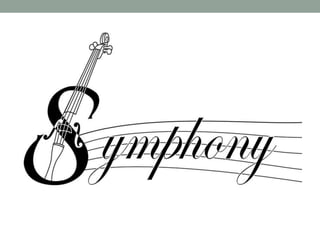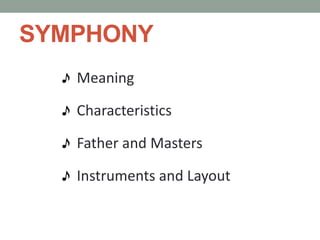Symphony Music
- 1. SYMPHONY
- 2. SYMPHONY Meaning Characteristics Father and Masters Instruments and Layout
- 3. MEANING OF THE NAME SYMPHONY
- 4. Meaning of ‘Symphony’ Symphony : ‘The word ‘symphony’ first appeared in the late 16th. At this time, however, it denoted nothing more specific than ‘music for ensemble’ --from the Greek, syn (‘together’) and phone (‘sounding’)’ (The Oxford Companion to Music edited by Alison Latham)
- 6. Characteristics • All instruments Sound together in harmony • Contrast of Mood • Flexibility of rhythm • Several Movements
- 7. Contrast of Mood • Contrasting themes within a movement • striking contrasts within a single theme. • The changes of mood, gradually or suddenly.
- 8. Flexibility of rhythm • Unexpected pauses • Syncopations • Frequent changes from long notes to shorter notes. • Various patterns of note lengths
- 9. 4 movements (Classic Style) • Also called ‘Sonata Form’ • Fast – Slow – Fast – Fast • 1st : A vigorous dramatic fast movement • Fast. Stress an exciting development of short motives. • Can be Anticipation sometimes: Slow> fast • 2nd: A lyric slow movement • Different key, pointing up the expressive contrast • 3rd: A dancelike movement (minuet or scherzo) • Moderate or fairly quick tempo • 4th : A brilliant or heroic fast movement • Lighter mood, or sometimes the climax. La matin
- 10. Symphony vs Concerto vs Sonata • Sonata : (1) A form of music structure (2) A kind of song written to play by only 1-2 instruments. • Symphony : Sonata for Orchestra • Concerto: modified 3-movement Sonata form, Excluding Minuet.
- 11. THE GREAT MASTERS OF SYMPHONY
- 12. Mozart
- 13. Wolfgang Amadeus Mozart • Mozart was an important influential composer of the classical era. • He composed over 600 works. ( 40 of symphony ) • He is among the most enduring popular of classical composers and his influence on subsequent Western art music is profound ; Beethoven composed his own early works in the shadow of Mozart and Joseph Haydn wrote that “posterity will not see such a talent again in 100 years” • His style of music : the classical style are all present in his music. • Clarity, Balance and Transparency are the hallmark of his work. • For example : Symphony No. 40 in G minor
- 14. Joseph Haydn
- 15. Joseph Haydn • The father of symphony • The father of the sting quartet • He was also a friend of Mozart and a teacher of Beethoven. • He composed over 104 works of symphony and many masterpieces in variety of music styles. • His style of music : His style is different in some ways from that of Mozart and Beethoven. His signature style is the musical humor. The most famous example is the sudden loud chord in the slow movement of his Surprise Symphony. There are many other musical humor in his works include numerous false ending. • Example : Symphony No. 103
- 16. Beethoven
- 17. Ludwig van Beethoven • He was a German composer and pianist. • His crucial figure in the transition between the classical and romantic eras. • He composed in several musical genres for a variety of instrument combination but only composed 9 of symphonies which each has its own unique style. • Beethoven compositional career is usually divided into 3 periods. - Early Period : strongly influenced by his predecessors Haydn and Mozart ( Symphony No. 1 and 2 ) - Middle Period : After his personal crisis ( enroaching deafness ). His works on this period are mostly express heroism and struggle. ( Symphony No.3 -8) Symphony No.5 - Late Period : Highly personal expression ( Symphony No. 9 )
- 21. Stringed Instruments Harp String instruments of the orchestra
- 24. The Wind Instruments 1. Wood Wind Instrument 1. Simple Blowing into a tube 2. Blowing through a reed 2. The Brass Instrument
- 25. The Wind Instruments Wood Wind Instrument 1. Simple Blowing into a tube 1. Flute Family (Flute, Piccolo) 2. Recorder Flute Piccolo Recorder
- 26. The Wind Instruments Wood Wind Instrument 2. Blowing through a reed
- 27. The Wind Instruments Wood Wind Instrument 2. Blowing through a reed
- 29. The Wind Instruments Brass Instuments cornet
- 30. Percussions • Fixed Percussion • Melodic Percussion
- 31. Percussions • Fixed Percussion Timpani Snare Drum Chimes Triangle cymbals Bass Drum Gong
- 32. Percussions • Melodic Percussion Tubular Bells Celesta Glockenspiel Piano
- 33. ORCHESTRA LAYOUT
- 34. Orchestra Layout • Orchestra – real ppl
- 35. Orchestra Layout
- 36. Orchestra Layout
- 37. References • Biography.com, (2014). Ludwig van Beethoven Biography. [online] Available at: http://www.biography.com/people/ludwig-van-beethoven-9204862#synopsis [Accessed 14 Sep. 2014]. • Grout, D. and Palisca, C. (1996). A history of western music. 1st ed. New York: W.W. Norton. • Kamien, R. (2008). Music. 1st ed. Boston: McGraw-Hill Higher Education. • Latham, A. (2002). The Oxford companion to music. 1st ed. Oxford: Oxford University Press. • Northernsounds.com, (2006). Lesson 1 - GENERAL REVIEW - Strings & Woodwinds: Northern Sound Source. [online] Available at: http://www.northernsounds.com/forum/showthread.php/45335-Lesson-1-GENERAL-REVIEW-Strings-amp- Woodwinds [Accessed 15 Sep. 2014]. • Wikipedia, (2014). Joseph Haydn. [online] Available at: http://en.wikipedia.org/wiki/Joseph_Haydn [Accessed 21 Sep. 2014]. • Wikipedia, (2014). Wolfgang Amadeus Mozart. [online] Available at: http://en.wikipedia.org/wiki/Wolfgang_Amadeus_Mozart [Accessed 14 Sep. 2014]. • คำโมง, ส. (2009). รู้รอบครอบจักรวาลดนตรี (All about music). 1st ed. กรุงเทพฯ: โอเดียนสโตร์. • ชลช่วยชีพ, บ., คชแสง, ก. and ขำวสะอำด, ว. (1981). คู่มือทฤษฎีและปฏิบัติการดนตรีสากล. 1st ed. กรุงเทพฯ: โอเดียนสโตร์.
Editor's Notes
- #5: Toey
- #13: http://www.mozart.it/images/mozart_ritratto.jpg
- #15: http://en.wikipedia.org/wiki/Joseph_Haydn
- #17: http://upload.wikimedia.org/wikipedia/commons/6/6f/Beethoven.jpg
- #21: http://www.learnmemusic.com/2009/03/young-persons-guide-to-orchestra.html
- #22: http://www.northernsounds.com/forum/showthread.php/45335-Lesson-1-GENERAL-REVIEW-Strings-amp-Woodwinds
- #23: http://www.northernsounds.com/forum/showthread.php/45335-Lesson-1-GENERAL-REVIEW-Strings-amp-Woodwinds
- #24: http://www.northernsounds.com/forum/showthread.php/45335-Lesson-1-GENERAL-REVIEW-Strings-amp-Woodwinds
- #29: http://www.northernsounds.com/forum/showthread.php/45335-Lesson-1-GENERAL-REVIEW-Strings-amp-Woodwinds
- #31: Ploy
- #35: Hong Kong Philharmonic Orchestra, 1957, from: http://hk-magazine.com/sites/default/files/imagecache/item_image/orchestra_1.jpg
- #36: Typical seating Layout, from: https://www.google.co.th/search?sa=G&q=orchestra+instruments&tbm=isch&tbs=simg:CAQSYxphCxCo1NgEGgAMCxCwjKcIGjwKOggCEhTGCuQU1g2CDuENqBy6C6sOiRWDHBogCN_1dkJUO0h6YSRxvX66UxjG7XnQA9biMM05KyQaum8gMCxCOrv4IGgoKCAgBEgSKwkHQDA&ei=j1MeVNGXLYWIuASNuYKoCA&ved=0CBkQwg4oAA&biw=1366&bih=677#facrc=_&imgdii=_&imgrc=5nUvRxOlaNmzTM%253A%3Bp4UlcsJmKXdo5M%3Bhttp%253A%252F%252Fandrewhugill.com%252Fmanuals%252Foverhead.gif%3Bhttp%253A%252F%252Fandrewhugill.com%252Fmanuals%252Fseating.html%3B1417%3B1046
- #37: http://cnx.org/resources/5ecf8a10b434d43f383dc8af6b641210/graphics1.png




































![References
• Biography.com, (2014). Ludwig van Beethoven Biography. [online] Available at:
http://www.biography.com/people/ludwig-van-beethoven-9204862#synopsis [Accessed 14 Sep. 2014].
• Grout, D. and Palisca, C. (1996). A history of western music. 1st ed. New York: W.W. Norton.
• Kamien, R. (2008). Music. 1st ed. Boston: McGraw-Hill Higher Education.
• Latham, A. (2002). The Oxford companion to music. 1st ed. Oxford: Oxford University Press.
• Northernsounds.com, (2006). Lesson 1 - GENERAL REVIEW - Strings & Woodwinds: Northern Sound Source. [online]
Available at: http://www.northernsounds.com/forum/showthread.php/45335-Lesson-1-GENERAL-REVIEW-Strings-amp-
Woodwinds [Accessed 15 Sep. 2014].
• Wikipedia, (2014). Joseph Haydn. [online] Available at: http://en.wikipedia.org/wiki/Joseph_Haydn [Accessed 21 Sep.
2014].
• Wikipedia, (2014). Wolfgang Amadeus Mozart. [online] Available at:
http://en.wikipedia.org/wiki/Wolfgang_Amadeus_Mozart [Accessed 14 Sep. 2014].
• คำโมง, ส. (2009). รู้รอบครอบจักรวาลดนตรี (All about music). 1st ed. กรุงเทพฯ: โอเดียนสโตร์.
• ชลช่วยชีพ, บ., คชแสง, ก. and ขำวสะอำด, ว. (1981). คู่มือทฤษฎีและปฏิบัติการดนตรีสากล. 1st ed. กรุงเทพฯ: โอเดียนสโตร์.](https://image.slidesharecdn.com/symphonypresentation-140928003056-phpapp01/85/Symphony-Music-37-320.jpg)